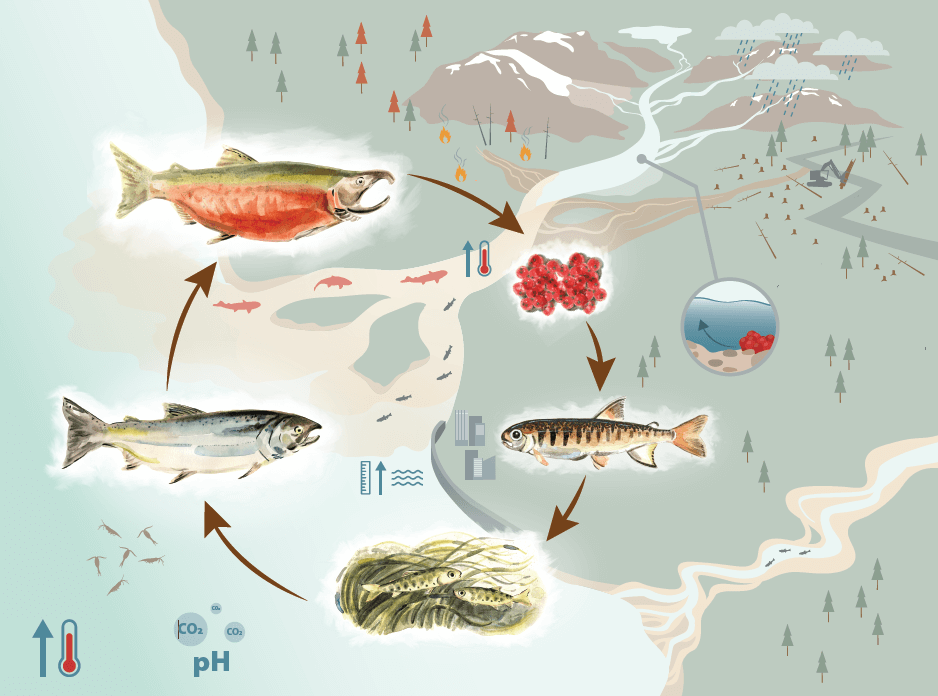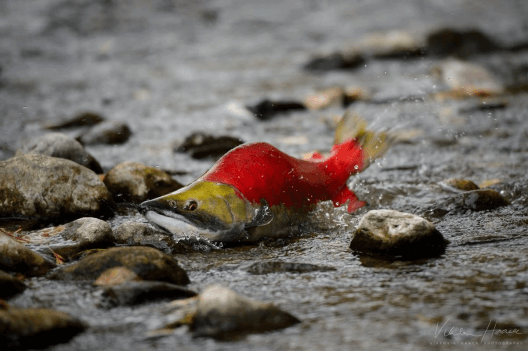Climate Change Conundrum
Where and why are B.C. salmon most vulnerable, and what can we do to help them?
Climate change has undoubtedly made its mark in British Columbia, as demonstrated by a year of extreme climate events throughout 2021. Record-breaking floods, droughts, heatwaves, and wildfires ravaged the province, affecting both human and ecological communities. Pacific salmon and their habitats were no exception.
Climate change is one of the most pressing risks to Pacific salmon populations. Salmon feel the effects of climate change at every stage of their life cycle.
However, not all salmon populations are equally vulnerable to the impacts of climate change. The PSF’s Salmon Watersheds Program has initiated a multi-year project to assess the climate change vulnerability of salmon populations throughout B.C. The results will show which populations are most vulnerable to climate change, why that might be the case, and what we can do about it.
“Climate change has affected, and will continue to affect salmon differently depending on the region in B.C. and the characteristics of each salmon population,” says Dr. Katrina Connors, director of PFS’s Salmon Watersheds Program. “These broad-scale climate change vulnerability assessments can help inform the prioritization of conservation and mitigation actions aimed at increasing the resilience of salmon populations.”

Watercolour illustration by Aimée van Drimmelen, Infographic by Fuse Consulting
PSF’s approach to assessing salmon vulnerability to climate change is two-fold. First, a research team led by PSF scientists identifies relevant climate indicators such as stream temperature, flow, sea surface temperature, and shoreline inundation, that reflect how salmon freshwater and marine habitats are changing. Second, the research team will determine each salmon population’s relative climate change vulnerability.
“The vulnerability of Pacific salmon populations will depend on the magnitude of their exposure to climate changes, as captured by the indicators we are compiling, but also on their biological sensitivity to these changes and their capacity to adapt,” says Dr. Stephanie Peacock, Salmon Watersheds Program analyst. “Pacific salmon display a wide diversity of life histories, meaning variability in sensitivity and adaptability. Climate change vulnerability assessments must factor in these differences.”
Ultimately, the visualization of climate indicators and climate change vulnerability of salmon populations throughout B.C. will be integrated into the Pacific Salmon Explorer. Launched in 2016, this data-visualization tool is continually expanded and updated to provide the most complete and up-to-date information on Pacific salmon and their habitats. The goal of the Pacific Salmon Explorer is to create a shared understanding of Pacific salmon status and trends among communities, conservationists, and decision-makers.
Climate Changes and the Consequences for salmon

FOREST FIRES can devastate salmon habitats in the short term – leading to landslides that fragment and degrade salmon habitats — but improve them in the long term by providing instream wood.

HIGHER STREAM TEMPERATURES are stressing all freshwater life stages, causing faster development of eggs and juveniles and higher en-route mortality of returning spawners.

Increased precipitation as rain in autumn, exacerbated by deforestation, leads to FLOODS that flush out juveniles and incubating eggs and can prevent returning adults from accessing spawning grounds.

LOWER SUMMER FLOWS can limit available oxygen in the water and restrict habitat for juveniles and spawners.

SEA-LEVEL RISE can lead to loss of estuarine rearing habitats, particularly in steep or urban areas where those habitats are restricted from shifting inland.

Rising sea surface temperatures and ocean acidification are SHIFTING MARINE FOOD WEBS, potentially increasing competition for resources and decreasing the availability of NUTRITIOUS ZOOPLANKTON to ocean-rearing salmon.
Visit our Salmon Watershed’s Program to learn more.
This work has been supported by the British Columbia Salmon Restoration and Innovation Fund (BCSRIF) through Fisheries and Oceans Canada and the Province of B.C.



